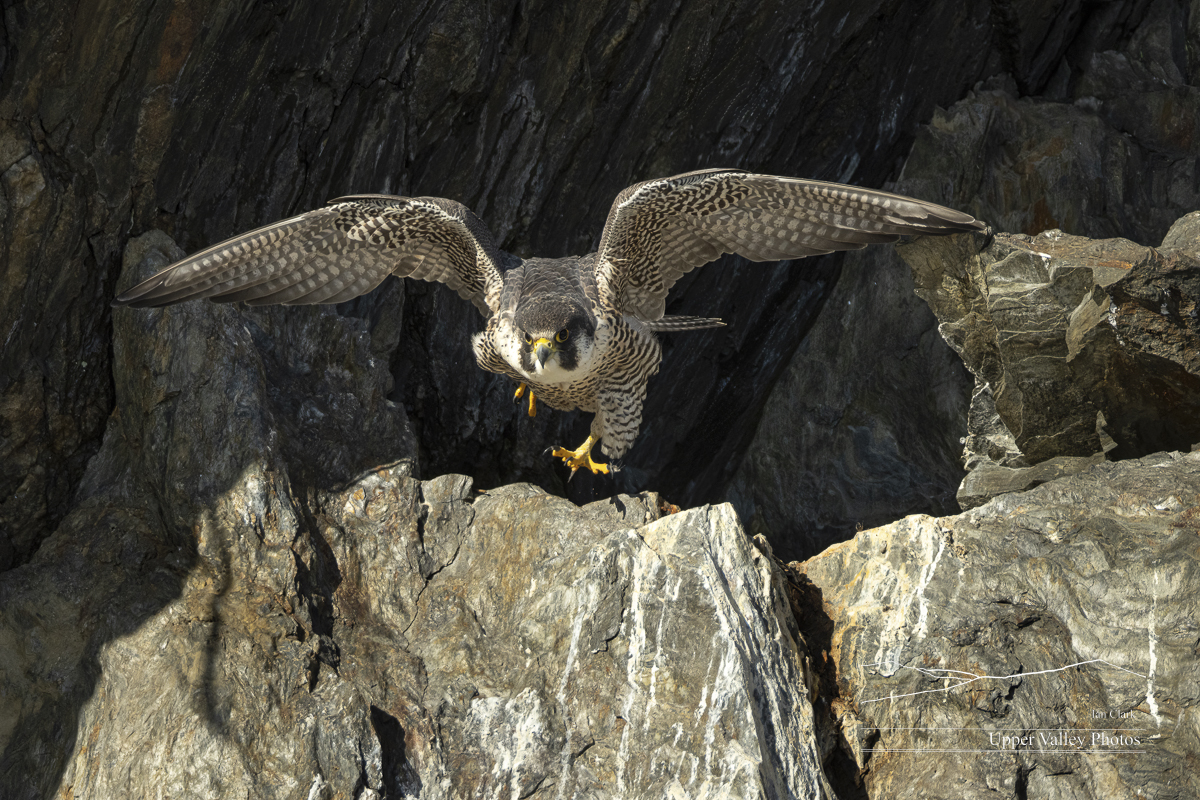

Peregrine Falcons Have Returned
Peregrine falcons have returned to Vermont and are getting ready to nest. I was able to visit a pair in Caledonia County this morning. They spent some time seemingly discussing their nest site, with one promoting last year’s site, the other agitating for a ledge a couple dozen yards to the north. They interrupted the discussion to head out for a flying courtship display. Unfortunately, the display was out of camera range.
Peregrines were extirpated (locally extinct) in Vermont after the introduction of DDT. The state started a recovery effort in 1975 and the population is increasing again. The last year I could find figures for was 2022, when there were an estimated 60 pairs nesting in Vermont.
Peregrines are thought to be the fastest animal on earth. They can dive in flight. Estimates online range from 200 to 240 mph, without my finding anyone who claims to have actually clocked a flying falcon. But, seeing one dive is indeed impressive and the estimates are believable.
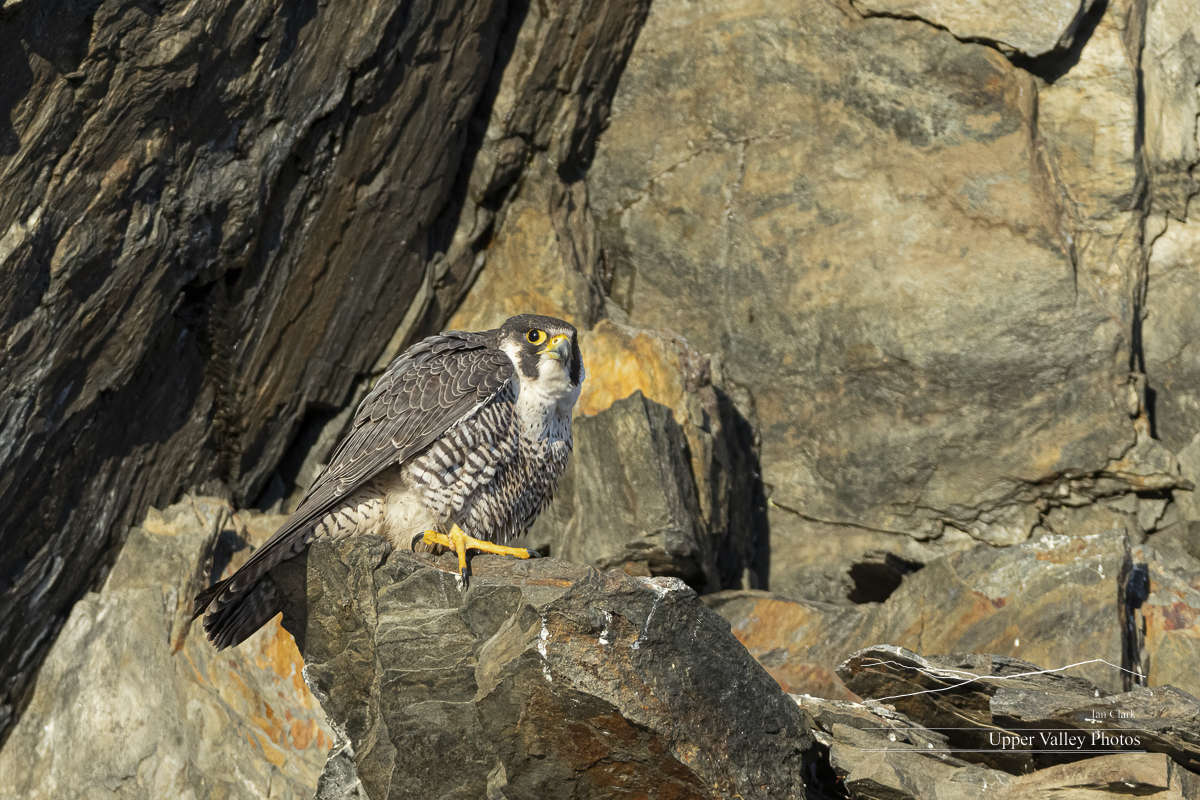


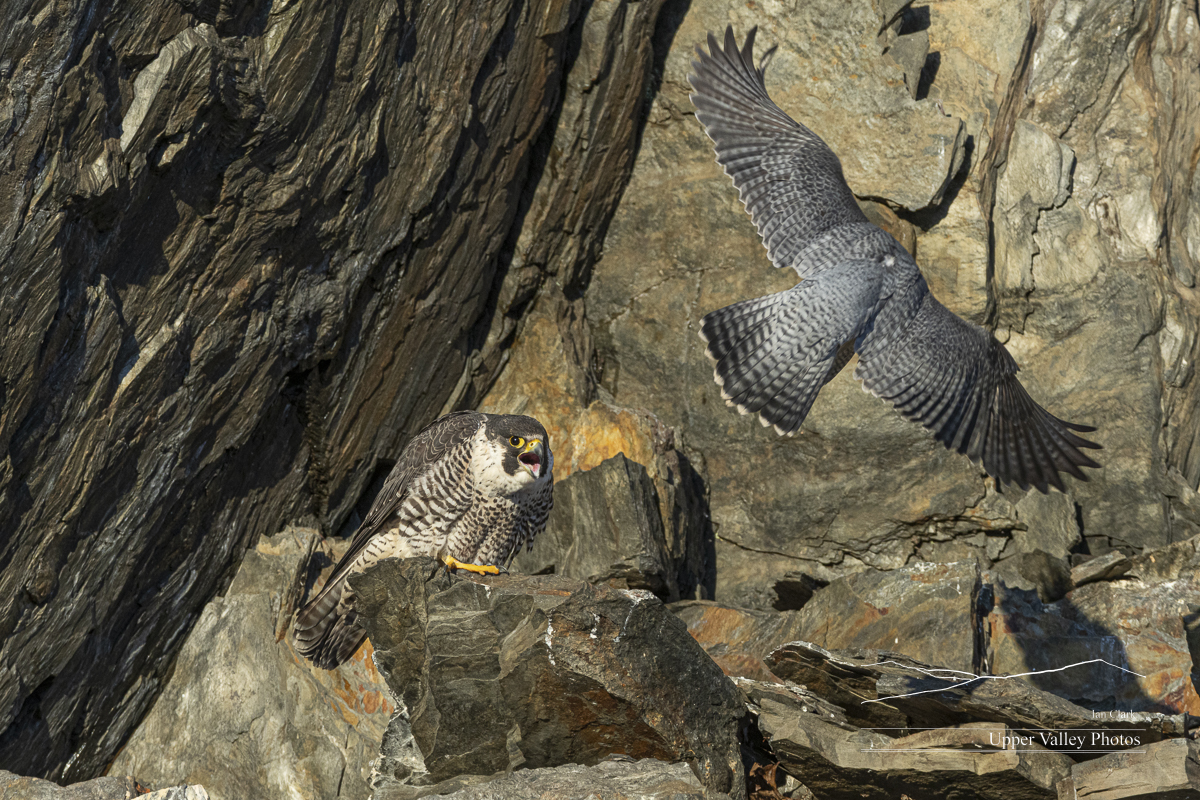



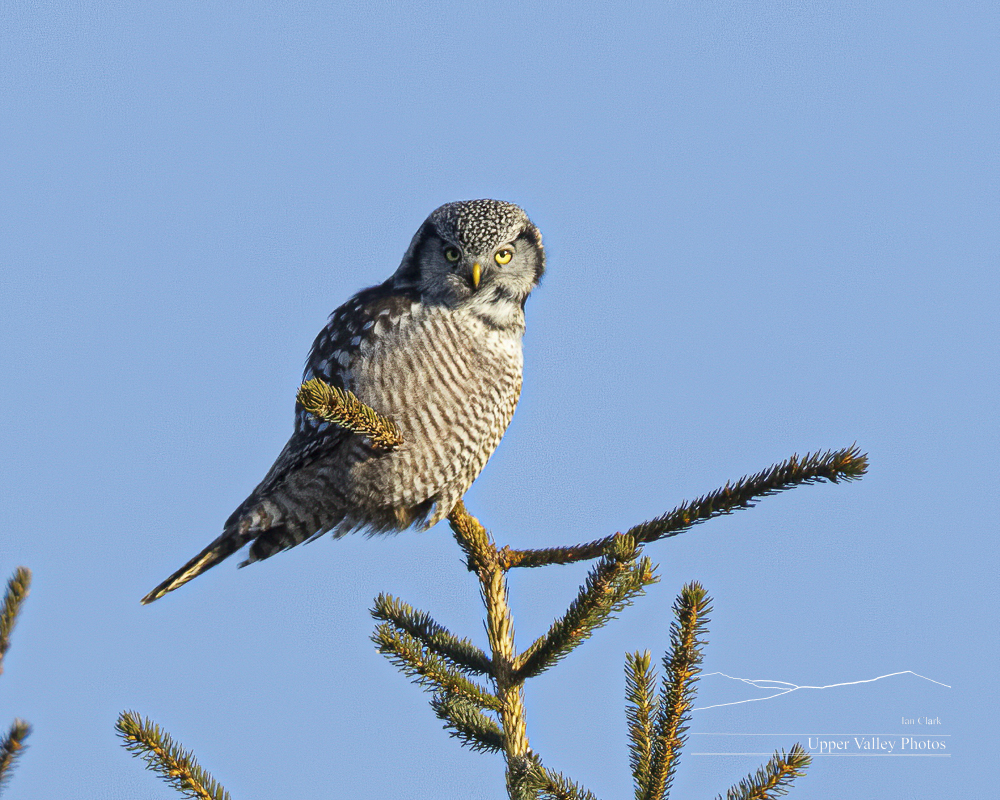

Northern Hawk Owl
The Piermont, NH, Public Library will be hosting me to present my slideshow, An Uncommon Look at the Common Loon, next Sunday, March 3, at 2 p.m. in the Old Church Building in Piermont. That’s right across Route 10 from the Library, not far south of the Route 10 and 25 intersection. Free and everyone welcome.
Northern hawk owls are small owls that live in the boreal forest, mostly north of the US. They’re occasional visitors to New England. I’ve heard of two in New England this winter. One has been persisting in Pittsburg, NH for the last couple of weeks. I went up to visit last Sunday.
Northern hawk owls are daytime hunters. Many owls have ears that are asymmetrical – they’re a bit offset from center on their heads. This allows them to pinpoint noises and allow them to hunt by ear. Northern hawk owls have symmetrical ears which lessen their ability to hunt by ear. They behave more like hawks and use exceptional eyesight – they seem to be able to see small rodents at half a mile. This means they’re out and about during the day, making photography much easier.
Easier, not easy. The owl visiting New Hampshire seems to prefer telephone poles and wires for perches – hardly photogenic.



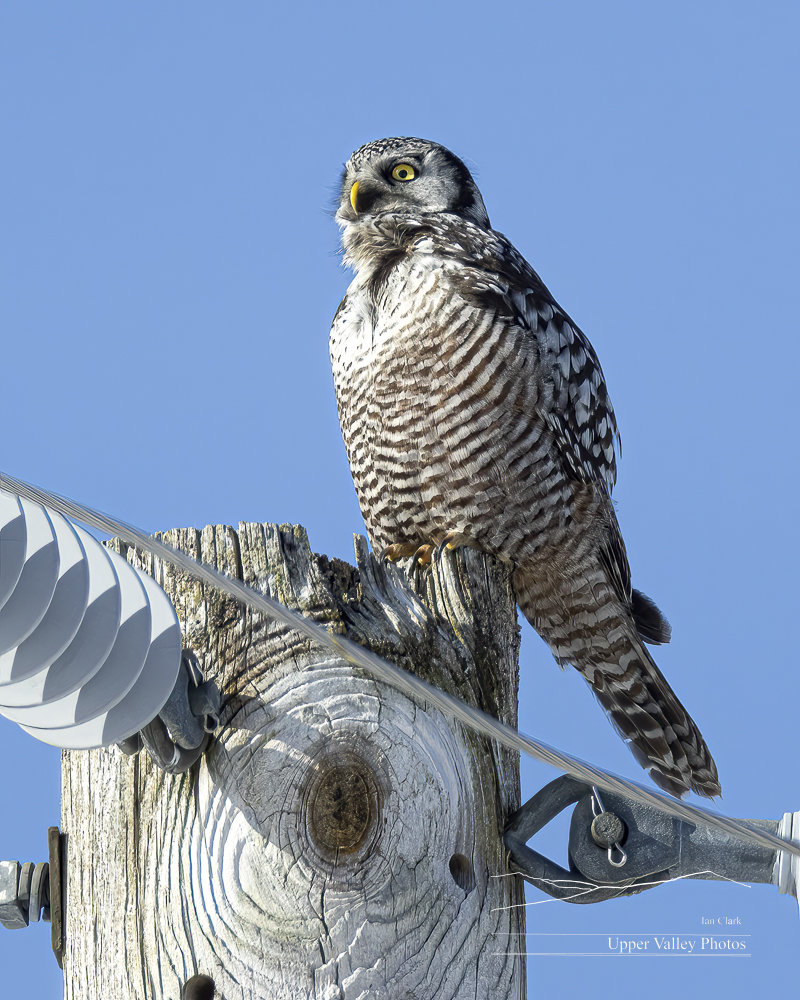





There were a couple flights of ducks along the river in Pittsburg. And, the bluebirds have been busy inspecting our bird boxes, we’re hopeful we’ll host them again this spring.
Upcoming Events
I hope everyone had a wonderful Thanksgiving. Just a quick update to let you know about a couple upcoming evenings.
I’ve got a slideshow of great loon photos, An Uncommon Look at the Common Loon. The Walker Lecture Series will be hosting me in Concord on Wednesday, November 29, 2023, at 7:30 (I’m the second speaker, I should start closer to 8:30). Free and everyone welcome.
All the details on Walker’s site: https://www.walkerlecture.org/schedule.
And, I still have some 2024 Wildlife Calendars available.
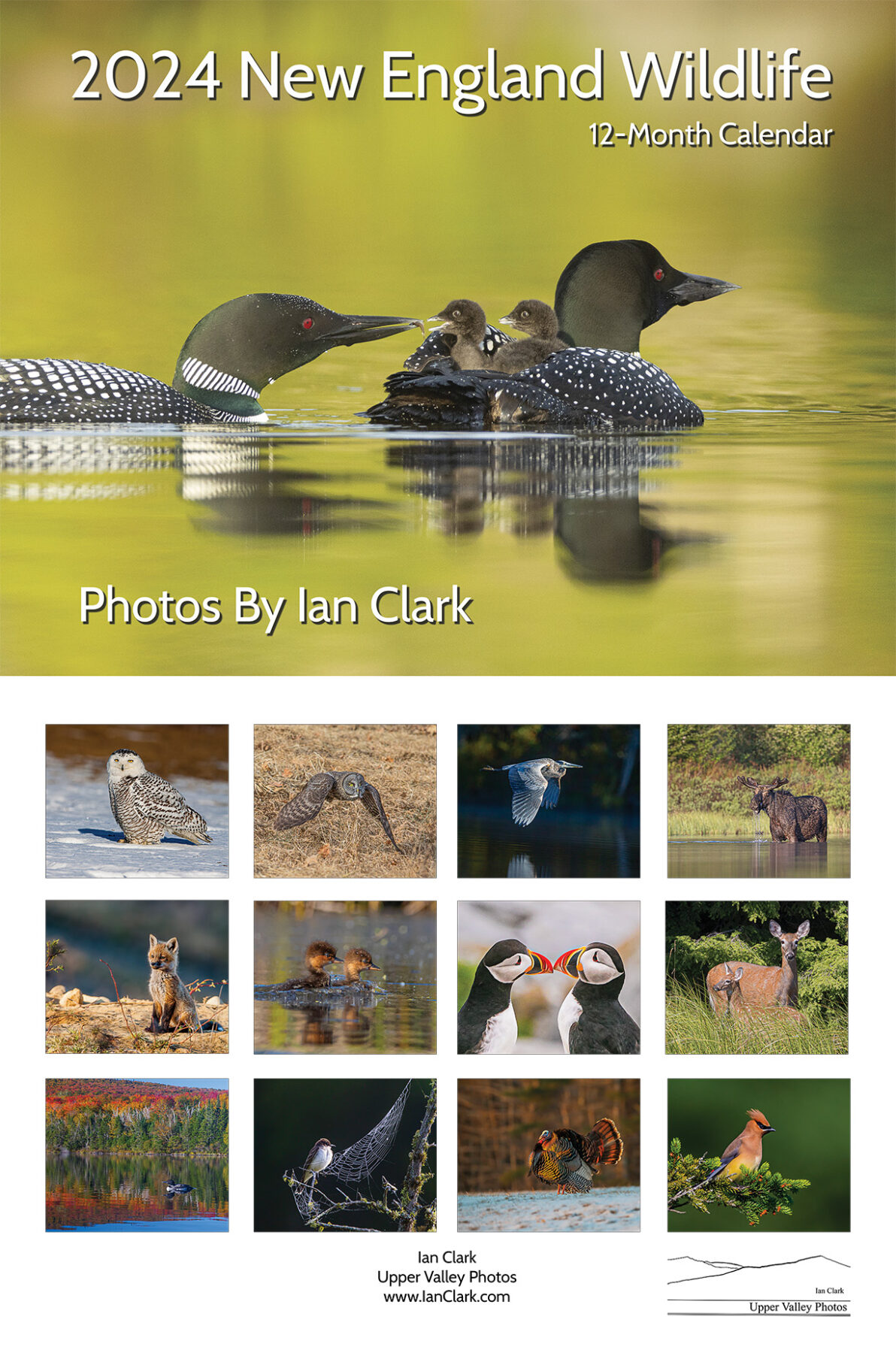
Last, I’ll be up at the Burklyn Arts Council’s Craft Fair in St. Johnsbury next Saturday. I’ll have calendars, lots of note cards and prints, large and small. Stop by and say hello.



A Visit to the East Broad Top Railroad
In October, I was able to revisit the East Broad Top Railroad in Orbisonia, PA. Pete Lerro of Lerro Productions organized a photo charter with EBT’s 2-8-2 no. 16 and a variety of antique cars and reenactors.
I’ll be giving a presentation on the surviving steam locomotives in the US on Wednesday, November 8 at 7:00 p.m. for the Haverhill Historical Society at Alumni Hall in Haverhill, NH. Free and everyone welcome. We’ll look at a variety of engines operating from coast to coast.
I’ve got a 2024 wildlife wall calendar available. They’re 9×12″ with 13 photos – the cover and 12 months. They’re $25. I can mail them to you for $3 an order if you’d like or catch me around town, I should have some with me. You can order them at www.IansPhotos.com.

The East Broad Top Railroad was a 3′ gauge coal hauler than ran from Broad Top Mountain to the Pennsylvania Railroad in Mount Union, PA. Built in 1873, the EBT ran until 1956. Since 1956, it has run, off and on, as a tourist railroad. In 2020 a new group of railroaders formed the EBT Foundation and brought the EBT back to life once again.

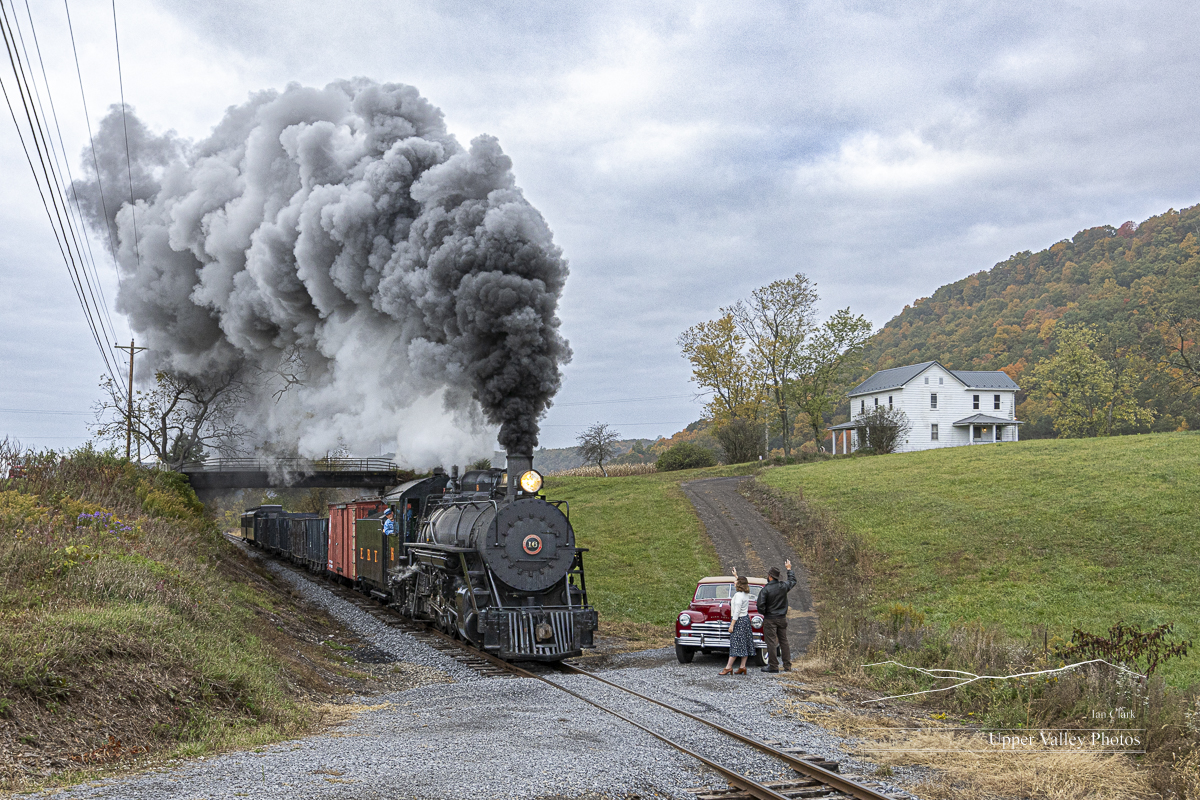





Pete always tries to come up with a creative shot after dark. This time he went all in, attempting to recreate O. Winston Link‘s Hotshot Eastbound. Link captured the original photo on August 2, 1956 in Iaeger, West Virginia. The photo required 42 #2 flashbulbs and one #0 flash bulb and was captured using a Graphic View camera that use 4×5” sheet film. The image of the airplane was added in the darkroom. Link’s image:
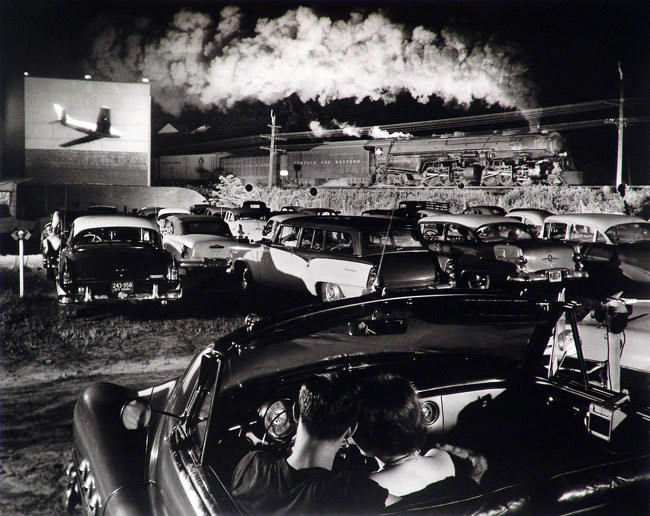










Inspiration for this last shot came from Harold M. Lambert Jr.’s shot of a soldier kissing his girl goodbye at the New Hope, PA station during WWII. Lambert’s shot:


The new management at EBT has made amazing progress restoring the railroad and buildings. They’re rapidly working to relay the track south of Orbisonia and restoring the other steam locomotives. They run steam excursions regularly. Certainly worth a visit. Get the details on their site: East Broad Top Railroad.
One Loon Chick Left
Thursday morning, I headed up to check on the Eastons. When I las visited, the parents weren’t on the pond and the chicks were practicing takeoffs, but couldn’t quite get airborne.
The adults usually stick around this pond until the last week of September, with the chicks departing in the first week of October. Looks like the parents took an early leave this year, with one chick following.
The chick on the pond was foraging lazily when I arrived. I watched for a time before hearing a loon calling overhead. I was expecting one of our parents to drop in to check on things, but the loon appeared to fly over.
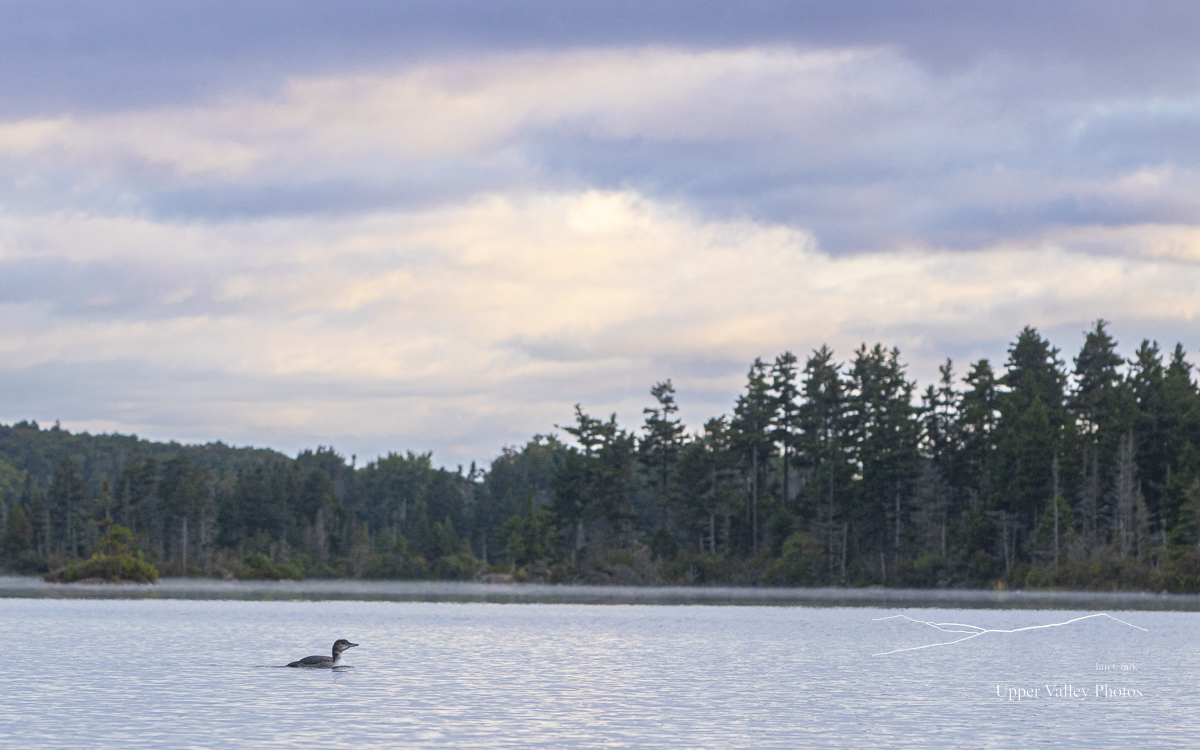
After a time, another loon was calling overhead – or maybe the same one that flew over before. Our chick tried to call. He’s first attempt sounded like someone stepped on a goose. But he quickly found his voice and yodeled.
That’s interesting for a couple reasons. First, only male loons yodel, so we know he’s a he. Second, that’s the response of an adult loon to an intruder. No longer is our chick hiding to protect himself.
The intruder landed at the far end of the pond. The exchanged wails and yodels for a time.



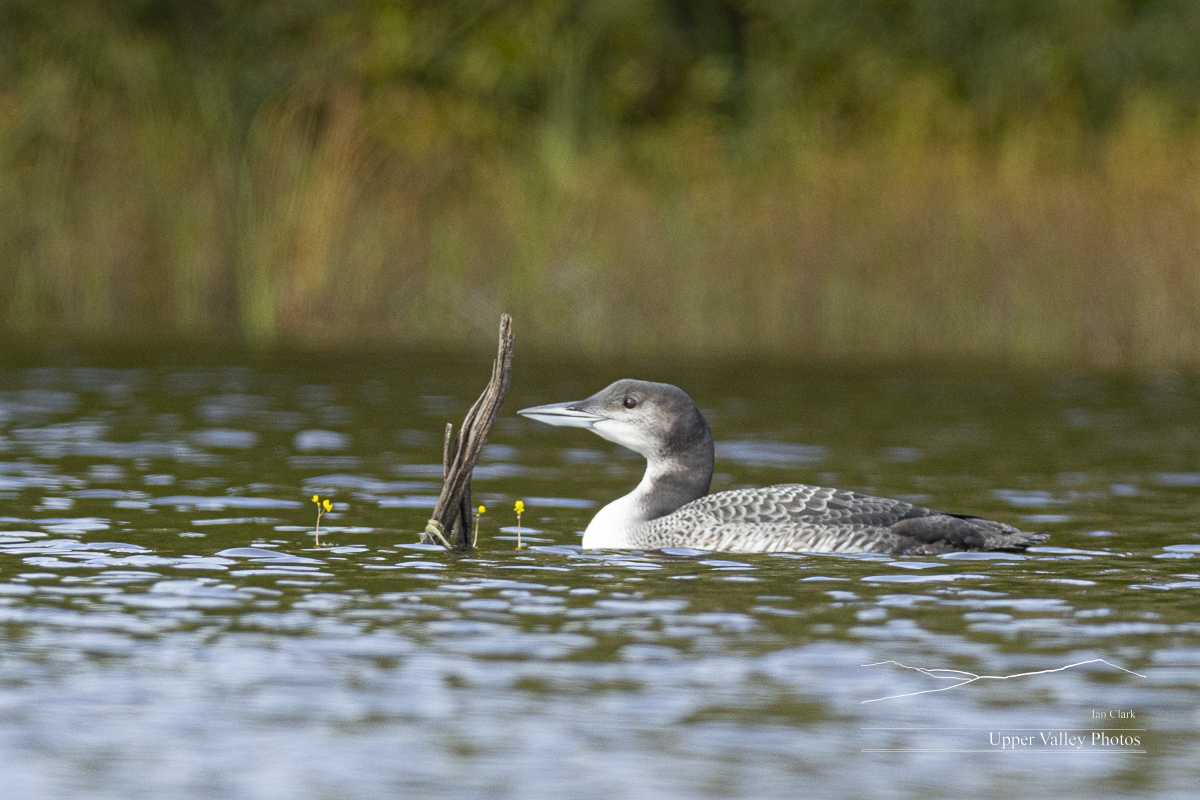




Learning to Fly, Checking in on the Loons
Our loon chicks are now 12 weeks old. They’re almost ready to take care of themselves. This week, they’ve been practicing adult calls, postures and they’re trying to fly. I was able to visit the Eastons twice since the last post.
I’ll be down at the Fall Crafts at Lyndhurst Show in Tarrytown, NY this Friday, Saturday and Sunday. Stop by to check out all the new images in prints and note cards. All the show details here.
Last Friday, the Eastons’ pond was above most of the fog at sunup. As I headed down the pond I met one chick coming up.












I returned to the pond Tuesday morning. The pond was mostly above the fog again. Beautiful blue skies and the hills to the west were in full sunlight. The pond was stuck in the shadow of one stubborn thick cloud.
The chicks were alone on the pond, both parents were elsewhere. The chicks were foraging about two-thirds of a mile apart. Both successfully feeding themselves. As the sun came up, a breeze grew and the chicks took time to practice flying.
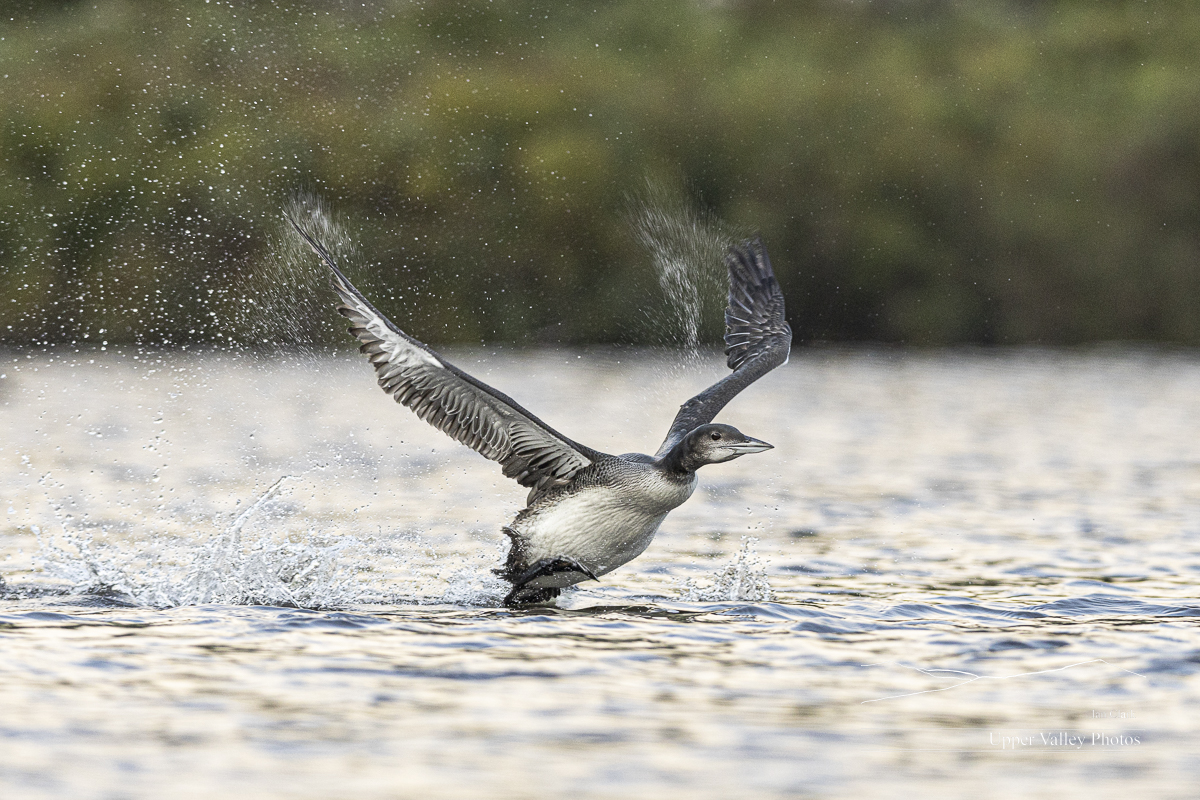



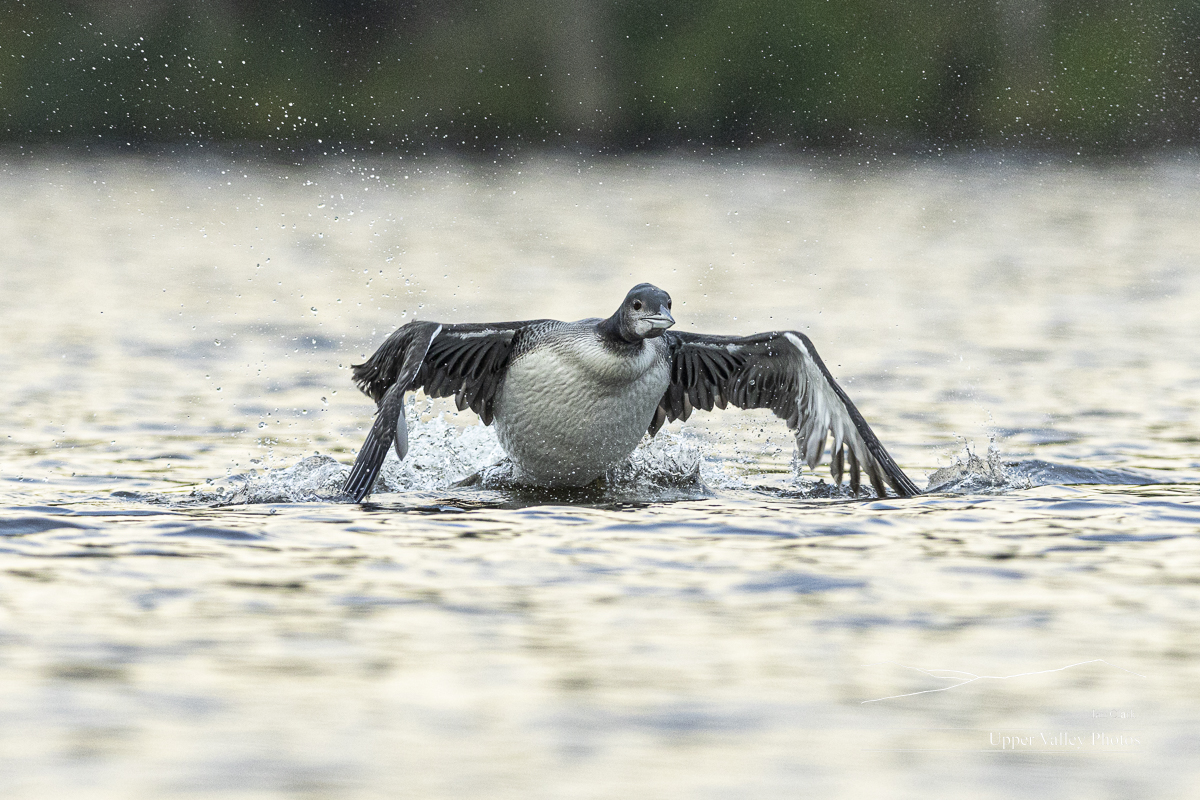







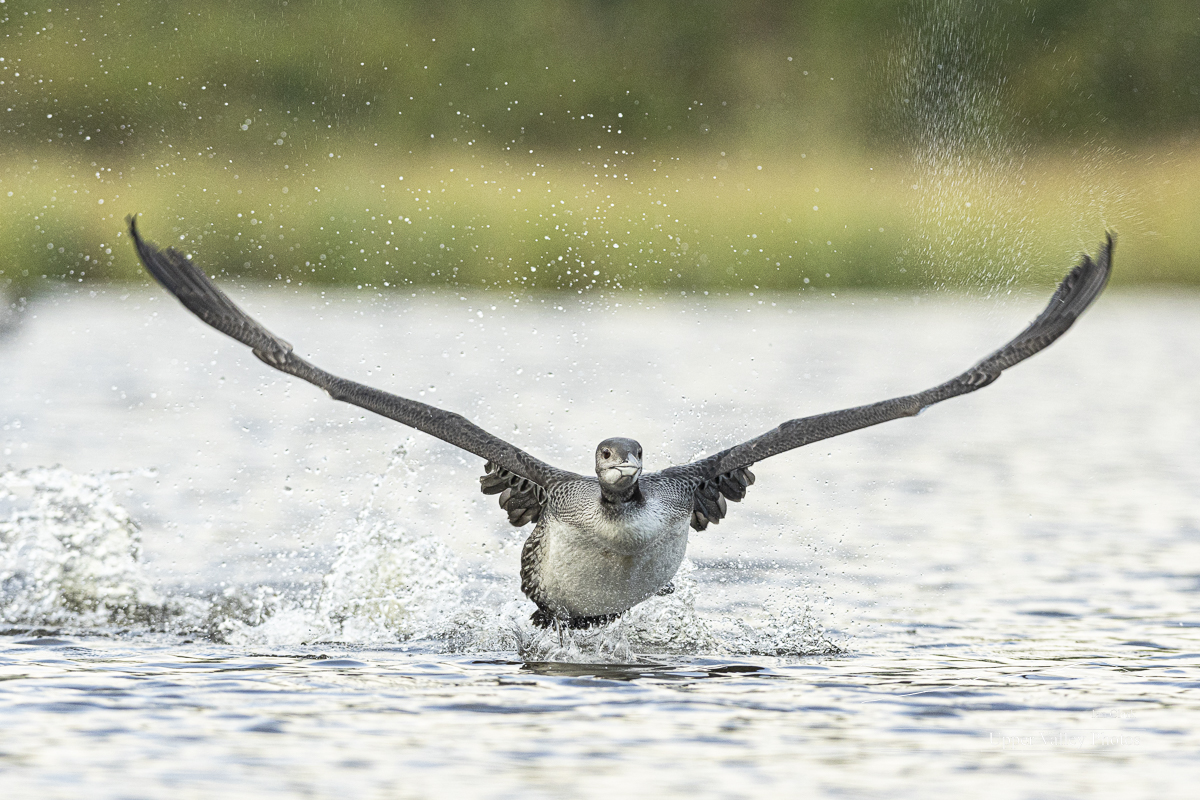
The Middletons appear to have scooted from their pond, they haven’t been spotted in almost a week. The Westons were doing well as of this past weekend. Both chicks are growing and getting independent. I’m hoping to get a chance to visit them before they head out.


Loon Chicks at 10 Weeks
Monday morning there were stars above and a thick fog over the river in the valley below. I decided to risk a trip to visit the Eastons. Most of the trip to the pond was slow going through the fog. As I started to climb towards the pond, I rose back above the fog to find a beautiful morning.
Dad was foraging by himself near the boat launch, he paddled in close to hoot softly to me before returning to feasting on crayfish. Mom called a couple times while I was getting the boat in the water. This is the pond where Dad is banded, letting me tell who is who if I can see a leg.


The chicks were keeping mom busy. They’re very demanding, poking and pulling feathers whenever she got near. She didn’t spend much time on the surface, she’d dive quickly when a chick got near. I’m convinced this is why the parents leave the pond before the chicks – they just want some peace.



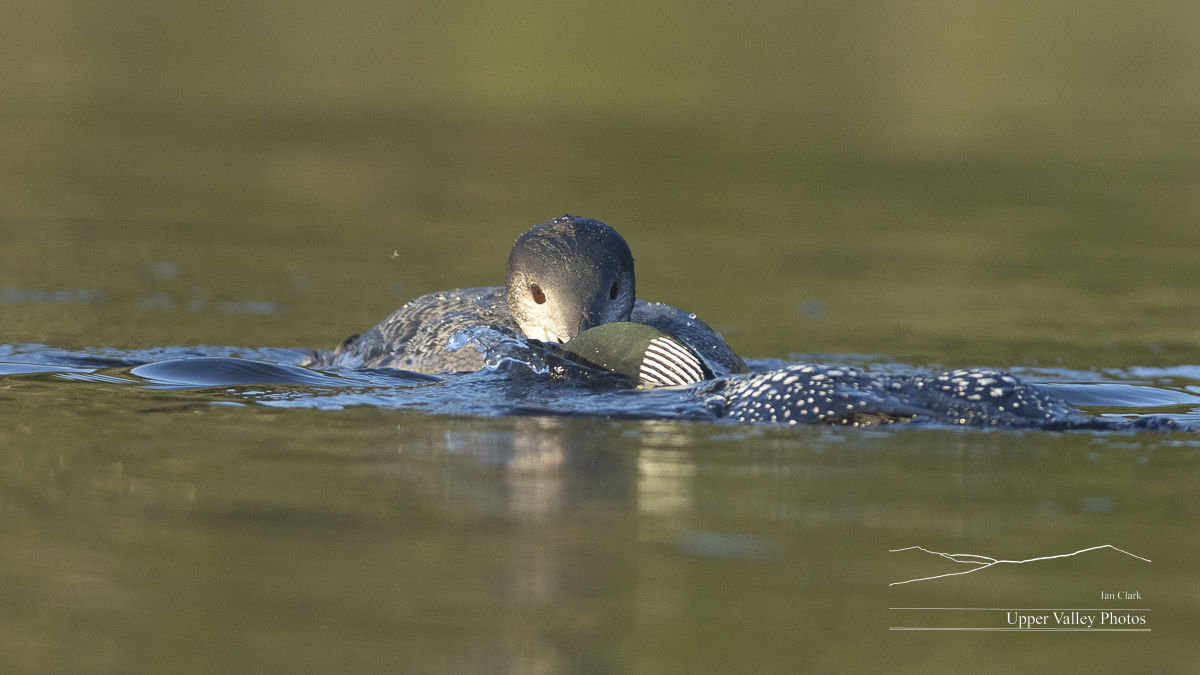

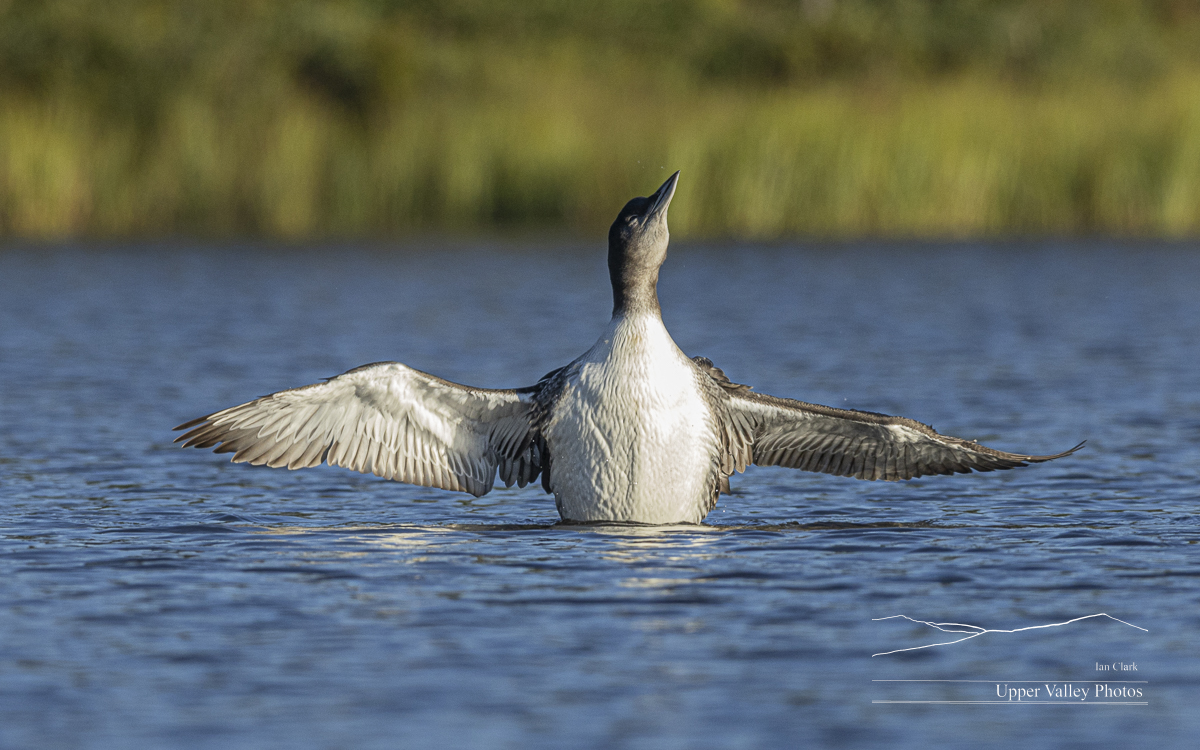









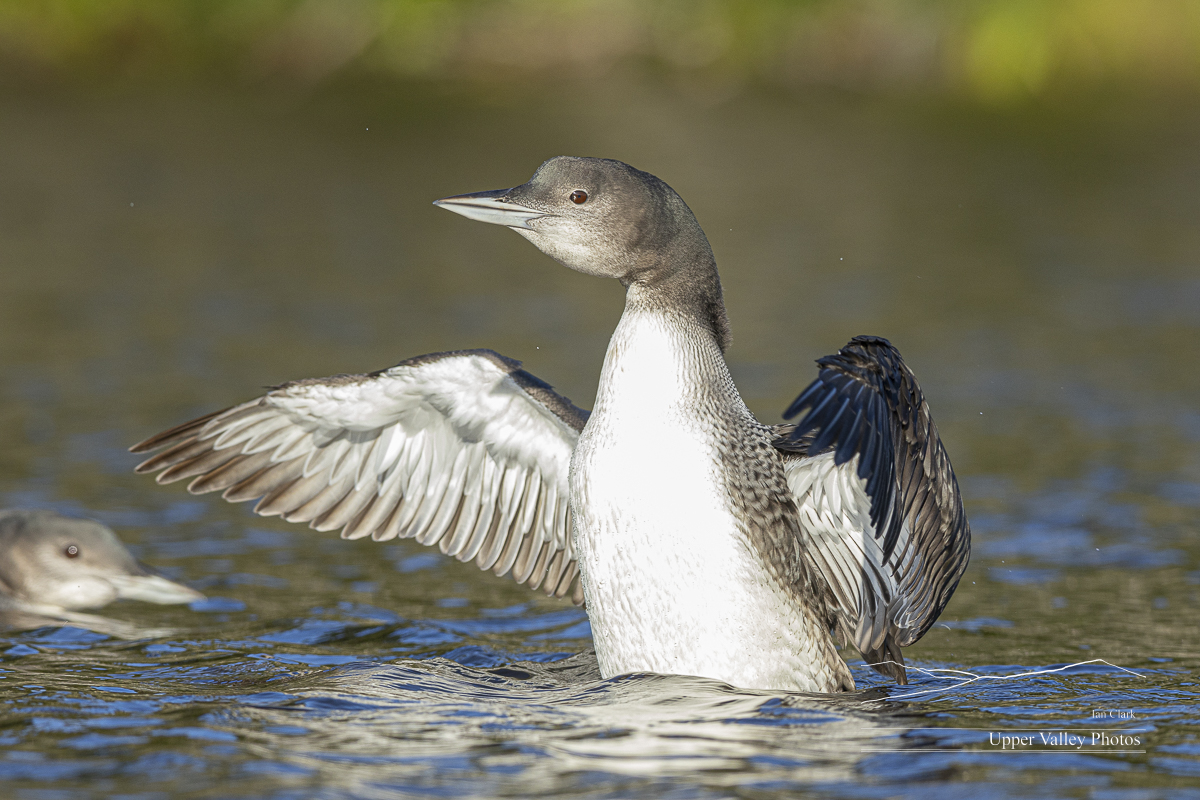



Heading back to the boat launch, I pass dad who is lazily paddling along, seemingly enjoying the peace and quiet on this end of the pond.
I was surprised the fog hadn’t shown up on the pond, there’s usually a period where the pond gets foggy as the fog lifts from the valley. Driving back towards home, I discovered why – the fog was still sitting heavy on the river.
Back at the house, the goldfinches have discovered the thistle I left for them.
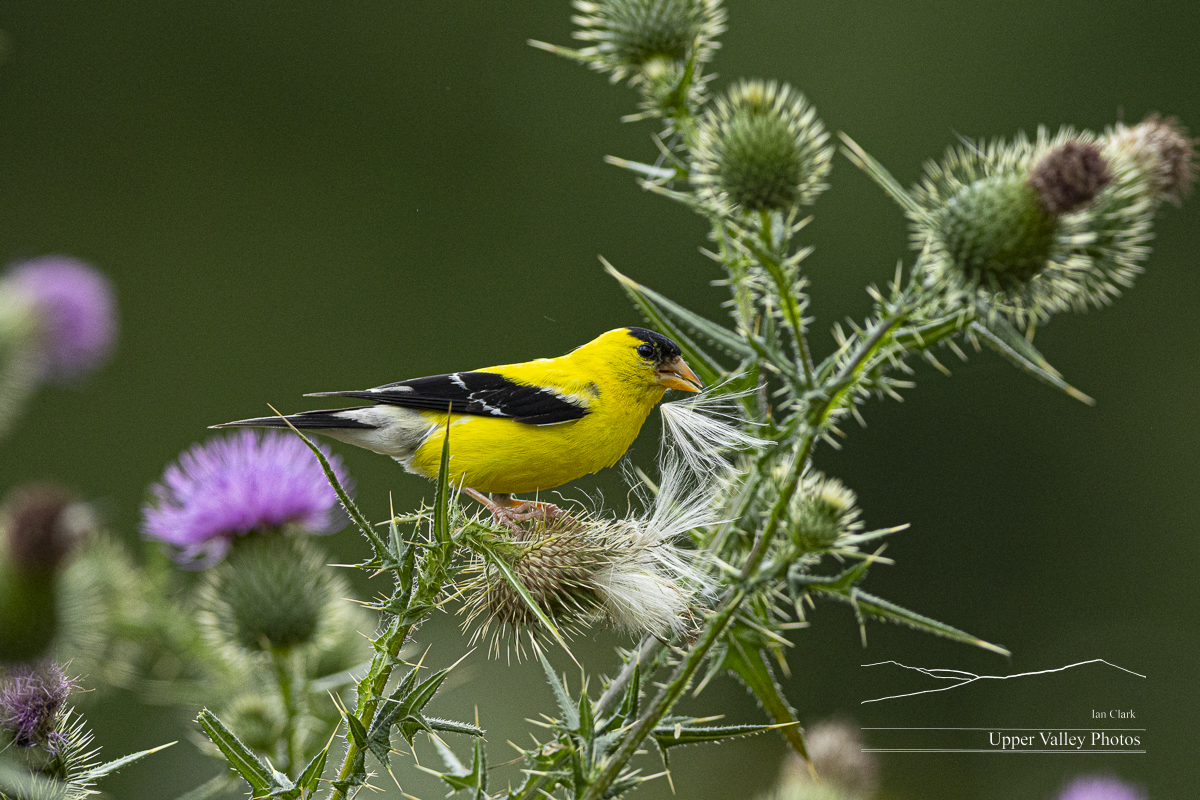
Loon Chicks Now Nine Weeks Old
Thanks to everyone who stopped by to say hello at the League of NH Craftsmen Fair. Nice to know there are actually people out there looking at my blog. My next show will be the Fall Crafts at Lyndhurst in Tarrytown, NY September 8, 9 & 10.
The weather and my travels have kept me from checking in on the loons since July 24 when I found the Eastons fighting with a pair of intruders challenging them for the pond. Sunday morning dawned without rain and only a light breeze. I headed back to check on the Eastons.



Sometime later, they headed back north and rounded a corner out of sight. A loon flying south appeared and circled to gain height to clear the hills as it departed. Mom took off and followed a few moments later.
Dad gathered the chicks and headed back south, foraging along the way. One chick was almost exclusively feeding itself while the second was putting dad to work.

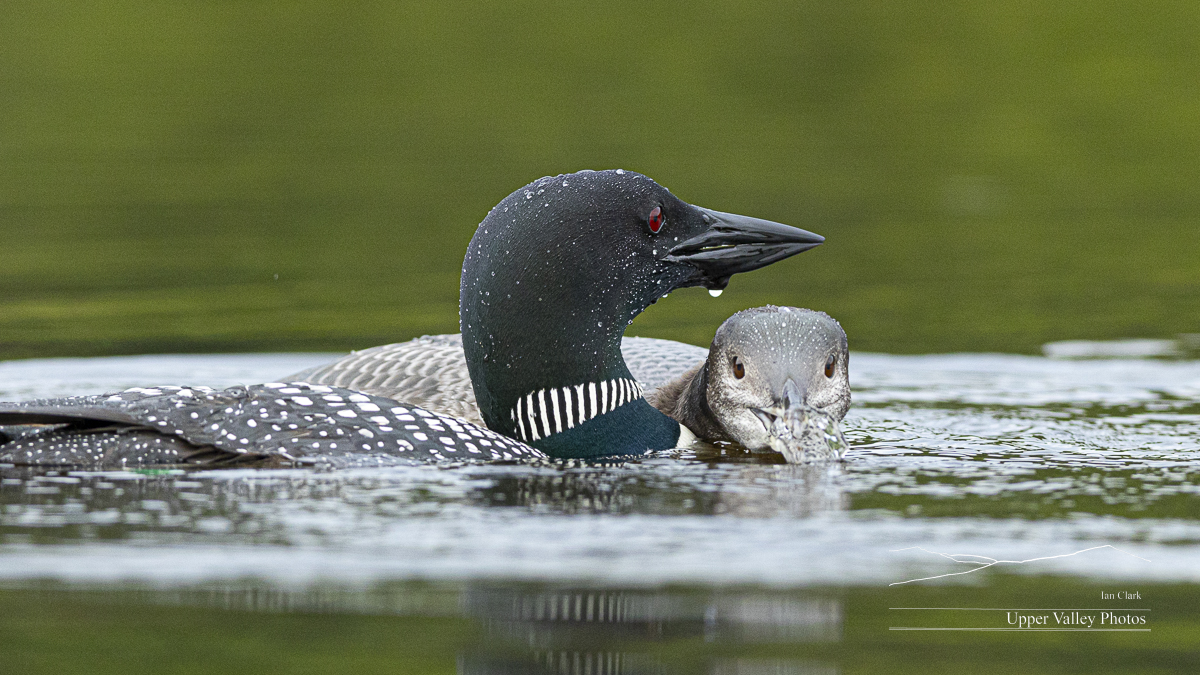







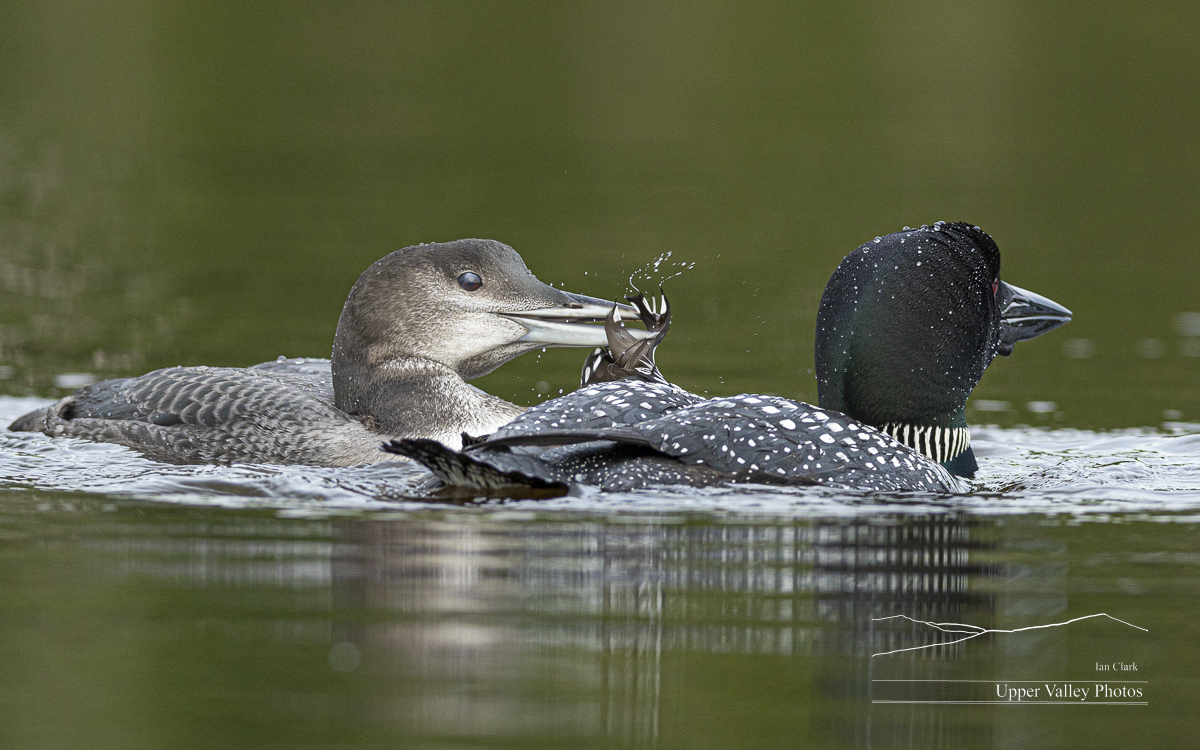
Our osprey made another dive that missed and circled a few times before heading off to the north.


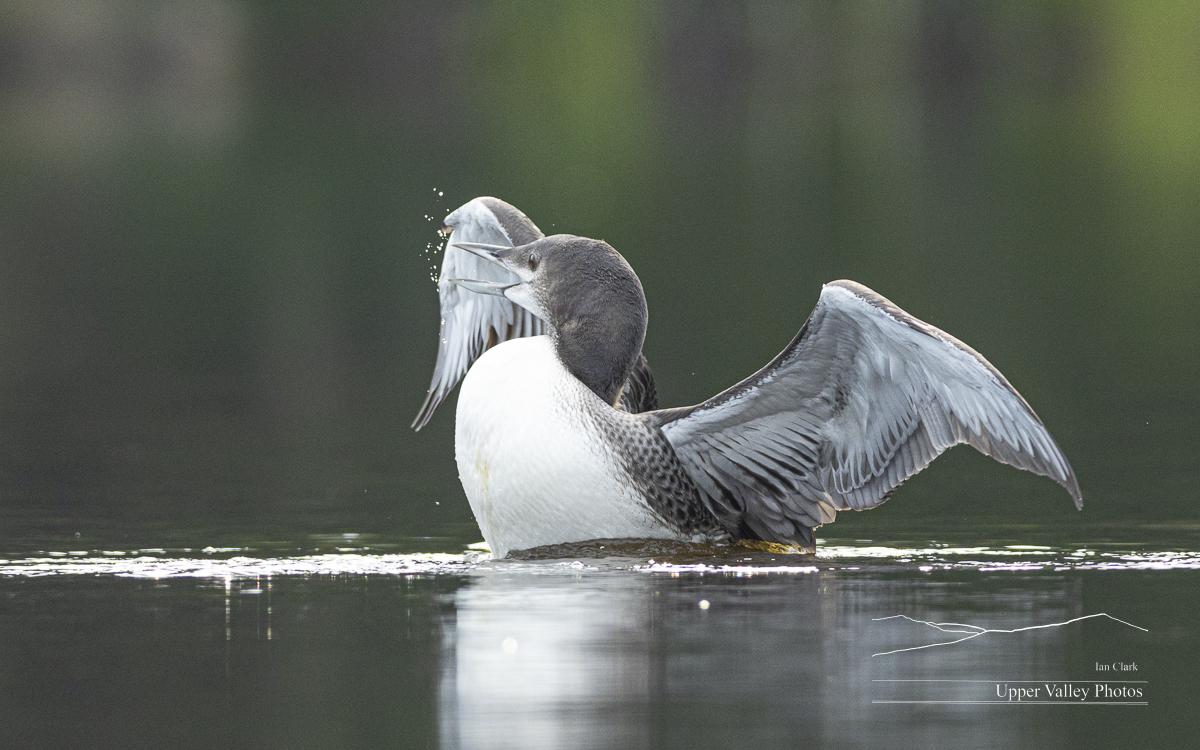

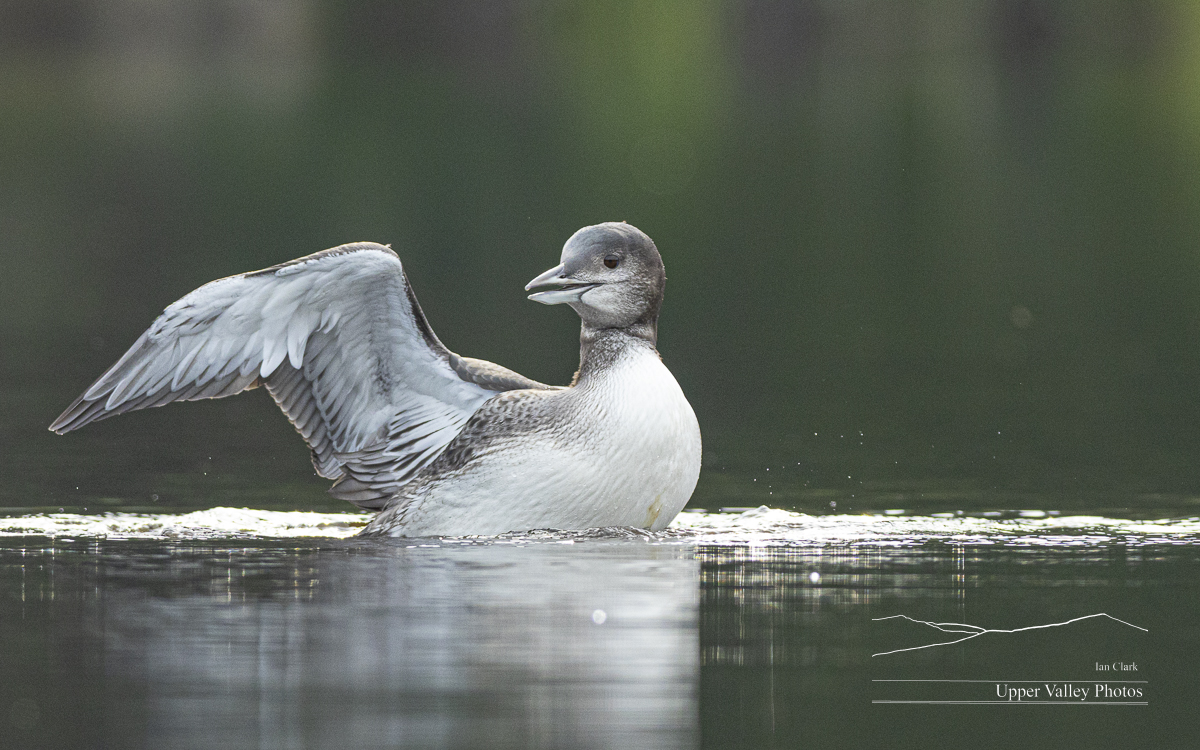




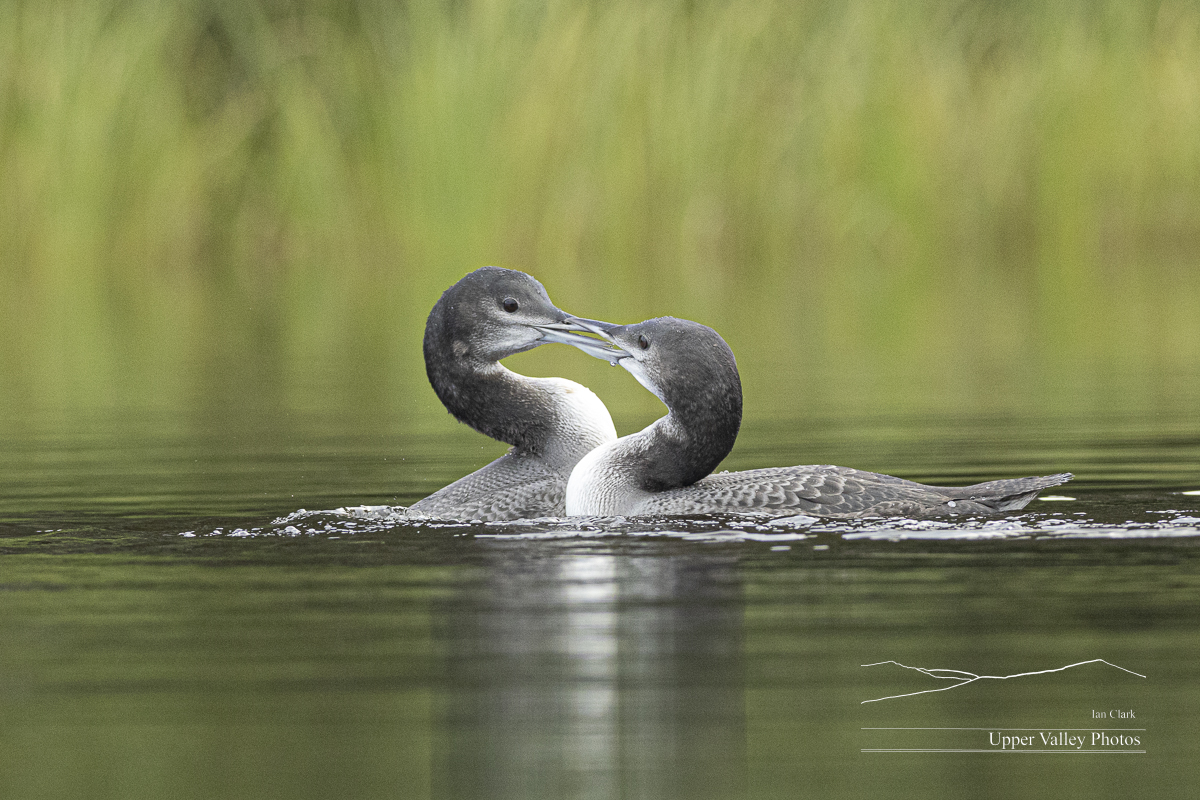

It was time for me to head out and I started paddling towards the boat launch.
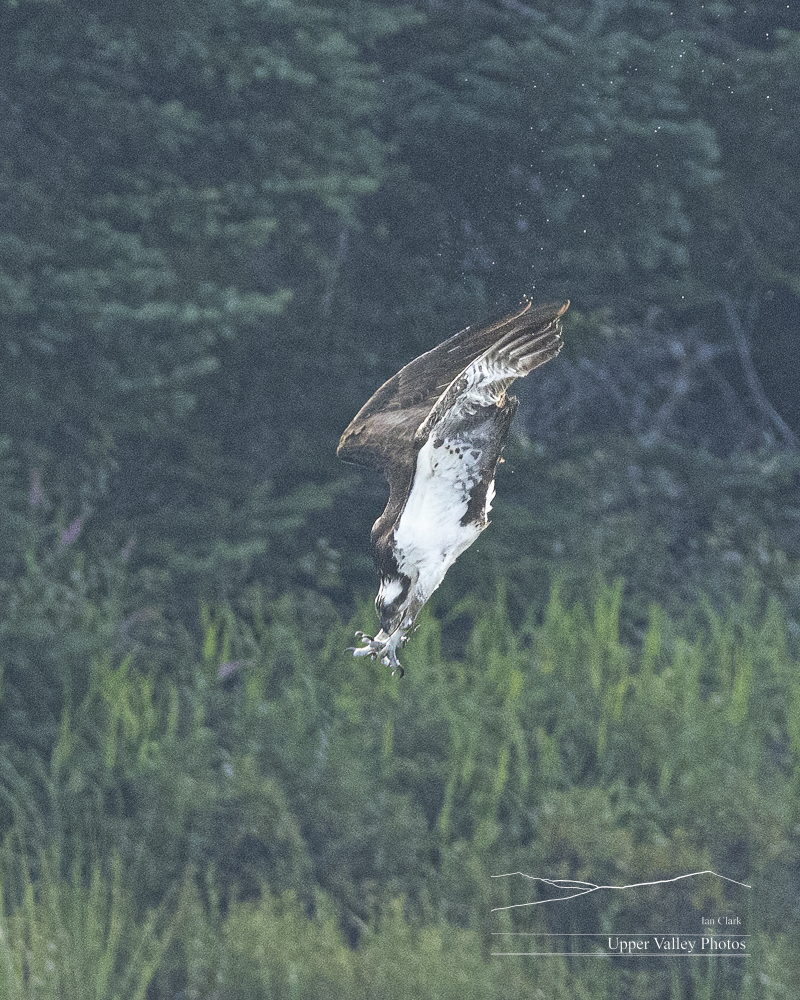

A friend on the Middleton’s pond tells me they’ve had intruders regularly over the past few weeks. I’m watching the weather and will get out to check on them and the Westons as soon as I can.
Puffins, et al, on Machias Seal Island

Machias Seal Island in the Bay of Fundy hosts large colonies of Atlantic puffins, razorbills and common murres, along with smaller numbers of common and arctic terns every summer. When I first heard about the island, I heard there were 2,000-4,000 puffins that nested there. Later I heard estimates of 4,000-6,000 and 6,000 to 8,000 puffins. The flock of murres was either slightly larger, or slightly smaller than the flock of puffins. This visit, I heard there were 8,000 pairs of puffins. So, I remain confused about how many birds there actually are. But, on a 15 acre (at high tide) island, there are plenty.
You have to visit the island with a tour. There are tour operators in Cutler, Maine and on Grand Manan Island, New Brunswick. The Maine operator sells his season out in minutes when he starts sales in January. This year, I ventured to Grand Manan with a friend to visit the island.
Puffins, razorbills and murres all live at sea and come ashore only to raise their young. We’re getting late in the season. Most of the razorbills and murres have fledged their chicks and returned to the sea. It was hard to tell how many puffins were still around. We had a hot day and many of them seemed to be in the water around the island. And, when they arrived on the island, they were usually hauling food for the pufflings. They’d land and quickly hop down into their burrow to feed the puffling.






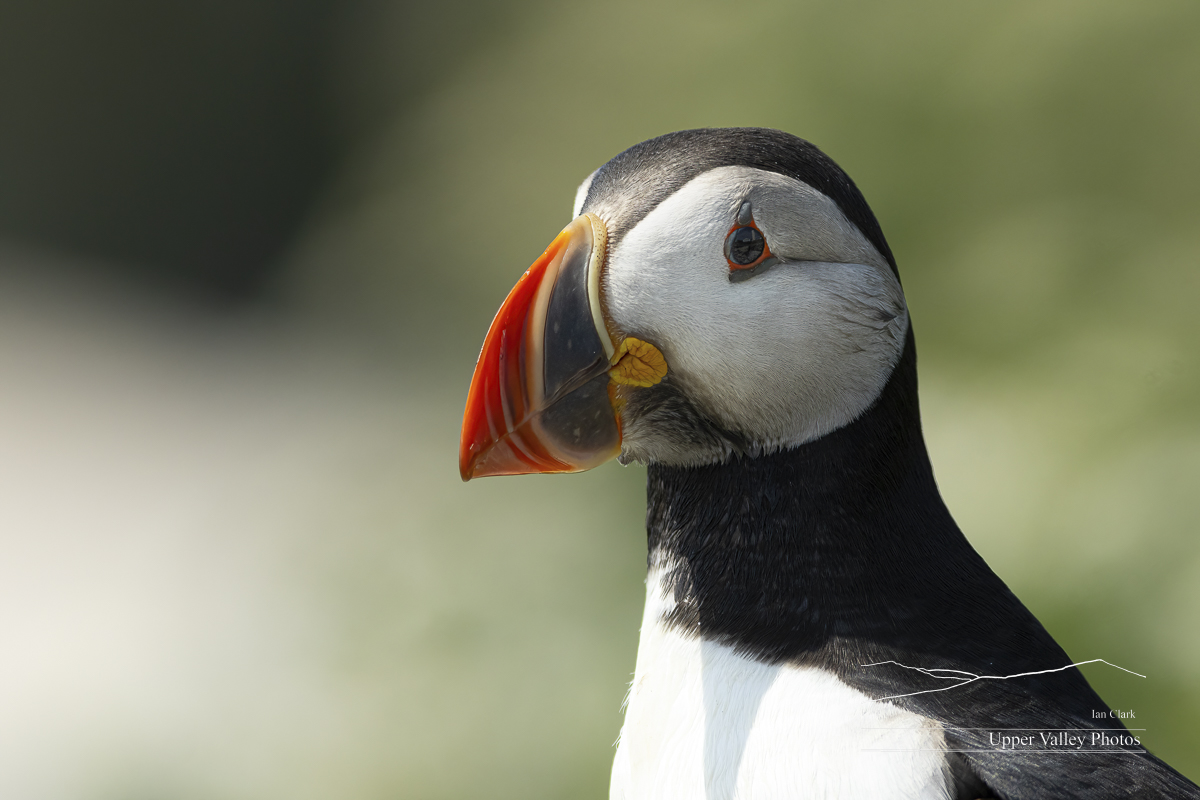







Probably won’t have time for any updates until after the League Fair. I’ll be out to check on the loons as soon as I can.
Battle for the Easton’s Pond
Sunday morning, the sky looked like there was a chance of some sunshine. I headed out to visit the Eastons. There was a light fog with hints of blue sky above when I arrived at the pond. And, it was a very pleasant 55° when I launched. The fog rapidly lifted for a beautiful morning. Our loon family was all together and the parents were both feeding the chicks.



One parent went north, one went south. It wasn’t long before the one to the south sounded an alert. The one to the north went steaming down the pond at a good clip.
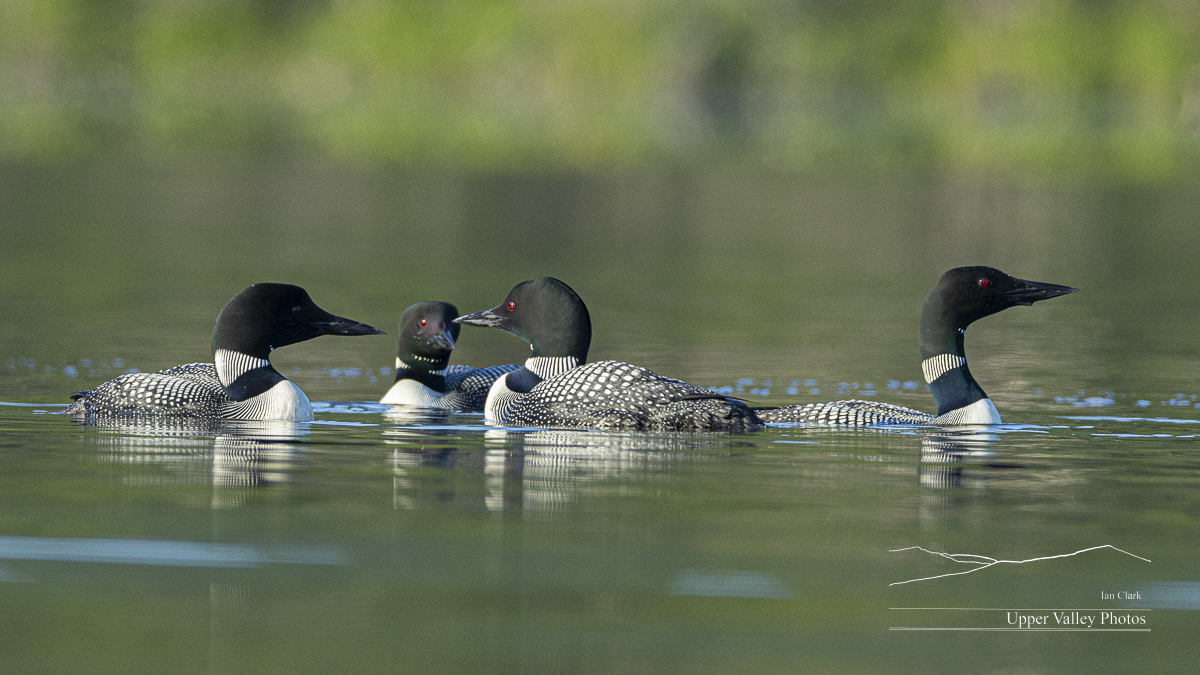



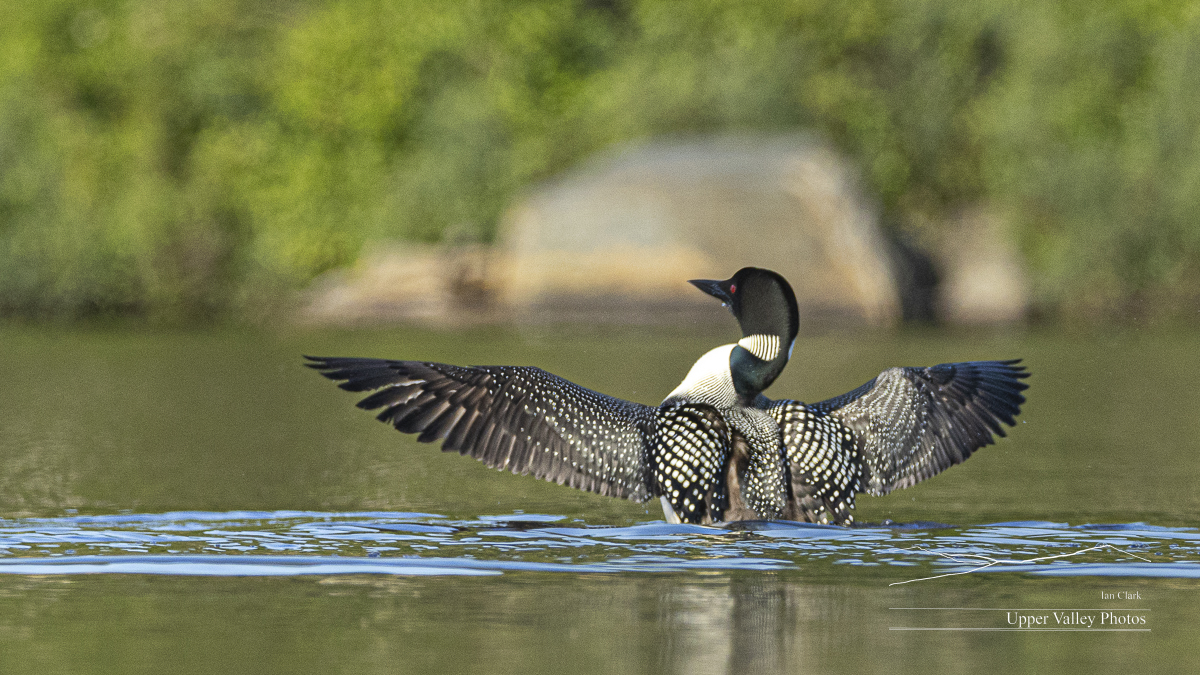

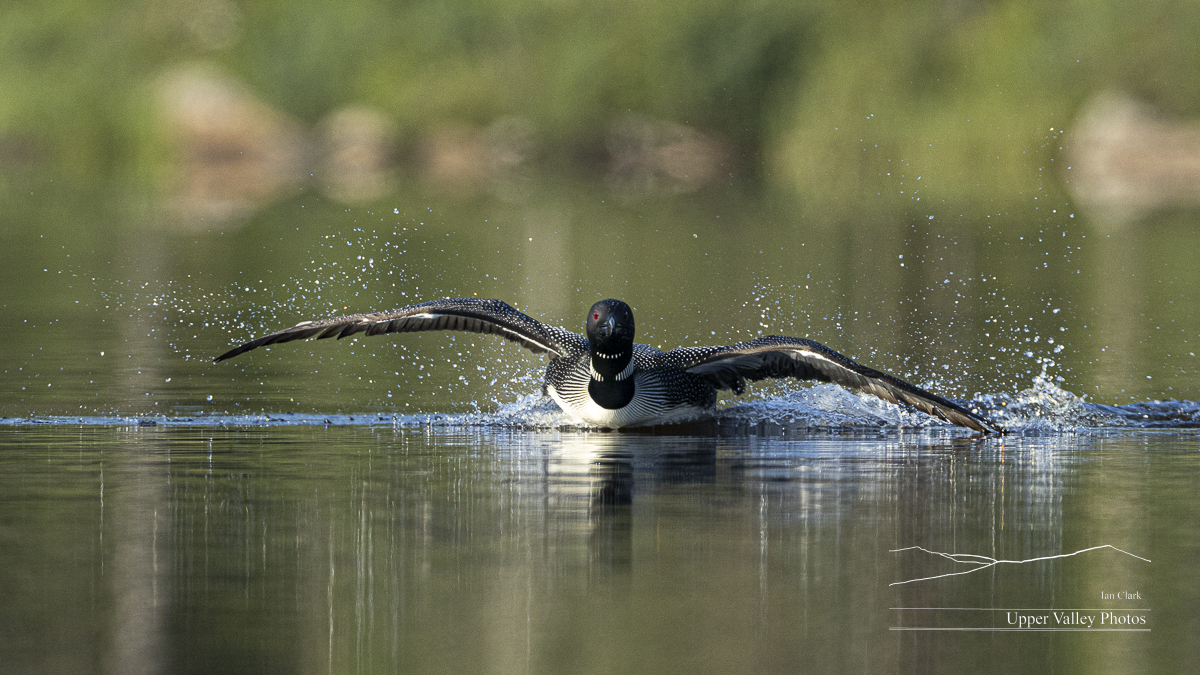







This morning, I went back up to the pond to see how the home team was making out.



After feeding the chicks, dad headed up the pond out of sight. Shortly, I could hear yodeling. Soon, a pair of loons showed up – a wing rowing chase. They covered a lot of ground, but didn’t get close enough for photos. Some time after that, a loon flew overhead coming from that end of the pond. A second loon swam down the pond and rejoined mom who was tending the chicks.
The home team held the pond this time. But the fight probably isn’t over. One or both of the intruders are likely to return for several days or even a couple of weeks. Loons pay attention to how well a territory produces chicks. This pond has successfully raised two chicks a season for at least the last three years running. It would be a good territory to take over if the intruder can.
I’m on the road starting Thursday, I probably won’t have time to visit to see how the battle goes. I’ll get back up there to check as soon as I get back.
PS, we’re not supposed to interfere with nature. Don’t tell anyone I’m rooting for the home team.
